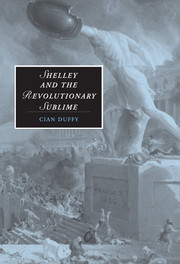Book contents
- Frontmatter
- Contents
- Acknowledgements
- Note on texts
- List of abbreviations
- Introduction: Approaching the ‘Shelleyan sublime’
- 1 From religion to revolution, 1810–1813
- 2 Cultivating the imagination, 1813–1815
- 3 Mont Blanc and the Alps, 1816
- 4 Writing the revolution: Laon and Cythna (1817)
- 5 ‘Choose reform or civil war’, 1818–1819
- Conclusion: ‘Good and the means of good’, 1822
- Notes
- Bibliography
- Index
- CAMBRIDGE STUDIES IN ROMANTICISM
1 - From religion to revolution, 1810–1813
Published online by Cambridge University Press: 15 December 2009
- Frontmatter
- Contents
- Acknowledgements
- Note on texts
- List of abbreviations
- Introduction: Approaching the ‘Shelleyan sublime’
- 1 From religion to revolution, 1810–1813
- 2 Cultivating the imagination, 1813–1815
- 3 Mont Blanc and the Alps, 1816
- 4 Writing the revolution: Laon and Cythna (1817)
- 5 ‘Choose reform or civil war’, 1818–1819
- Conclusion: ‘Good and the means of good’, 1822
- Notes
- Bibliography
- Index
- CAMBRIDGE STUDIES IN ROMANTICISM
Summary
On Sunday 11 October 1813, Shelley's first wife, Harriet Westbrook, wrote to her Irish friend, Catherine Nugent, from Ambleside, in the heart of the English Lake District. ‘We are again’, Harriet affirmed, ‘among our dear mountains’ (Letters, i, p. 378 n. 3). Her remark comes at the end of a two-year period during which she and Shelley had lived in some of Britain's most dramatic landscapes: the North Wales mountains and the Lake District. These were undoubtedly the most politically active years of Shelley's life. But they also witnessed the beginning of his lifelong engagement with the British discourse on the natural sublime, an engagement surely prompted by the grandeur of the surroundings in which he chose to live. To put it more precisely, the years 1810–12 witnessed Shelley's first attempts to revise the British discourse on the natural sublime along politically radical lines. These attempts bore fruit in Queen Mab's already cited claim that it is possible to ‘rightly’ feel the ‘mystery’ of natural ‘grandeur’. But this success was not won without cost. Rather, the years 1810–12 also saw the emergence of deep-rooted ambiguities, ambiguities that would not only problematise Shelley's attempt to bring the discourse on the natural sublime within the pale of radical politics, but which would ultimately call into question the entire gradualist tenor of his political thought.
- Type
- Chapter
- Information
- Shelley and the Revolutionary Sublime , pp. 13 - 48Publisher: Cambridge University PressPrint publication year: 2005
- 1
- Cited by

